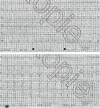Flecainide-Associated Cardiogenic Shock in a Patient with Atrial Fibrillation
- PMID: 31827935
- PMCID: PMC6885768
- DOI: 10.1155/2019/4820652
Flecainide-Associated Cardiogenic Shock in a Patient with Atrial Fibrillation
Abstract
Flecainide is a frequently used antiarrhythmic drug, recommended by current guidelines as a first-line treatment option for restoring and maintaining sinus rhythm in patients with atrial fibrillation and no significant structural heart disease. In overdose, it can induce severe cardiogenic shock. Cardiogenic shock after a therapeutic dose of flecainide in patients without contraindication has not yet been reported in literature. Case Summary. We report a case of flecainide-associated cardiogenic shock in a 52-year-old woman with paroxysmal atrial fibrillation after a therapeutic dose of flecainide. Pharmacological cardioversion of symptomatic tachyarrhythmic atrial fibrillation with flecainide was unsuccessful and shortly after, she developed cardiogenic shock with severely reduced LVEF. Electrical cardioversion was also unsuccessful. Coronarography was unremarkable, and the cardiac MRI showed no signs of inflammation or fibrosis. After amiodarone loading, she converted to SR. This rare but severe complication despite adequate treatment could be explained by increased susceptibility to negative inotropic effect of flecainide as a consequence of marked tachycardia. Therefore, cautious monitoring after new administration of flecainide or the administration of a higher dose is advisable.
Copyright © 2019 Erind Gjermeni et al.
Conflict of interest statement
The authors declare that they have no conflicts of interest.
Figures


References
Publication types
LinkOut - more resources
Full Text Sources
Research Materials

